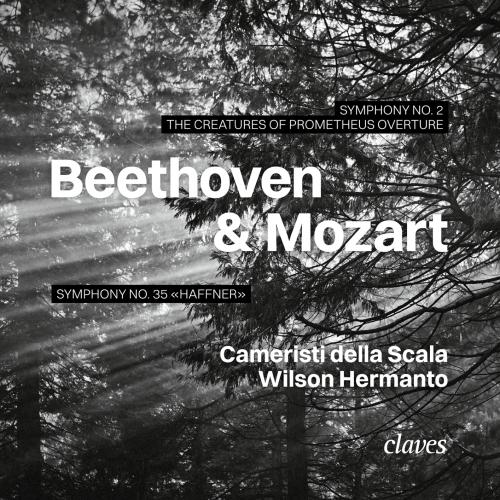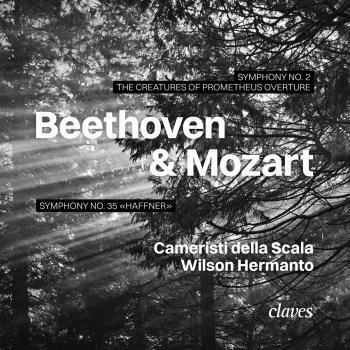
Beethoven: Symphony No. 2 in D Major, Op. 36 & Mozart: Symphony No. 35 in D Major, K. 385 “Haffner” Cameristi della Scala & Wilson Hermanto
Album info
Album-Release:
2024
HRA-Release:
08.11.2024
Label: Claves Records
Genre: Classical
Subgenre: Orchestral
Artist: Cameristi della Scala & Wilson Hermanto
Composer: Ludwig van Beethoven (1770–1827), Wolfgang Amadeus Mozart (1756-1791)
Album including Album cover Booklet (PDF)
- Ludwig van Beethoven (1770 - 1827): Symphony No. 2 in D Major, Op. 36:
- 1 Beethoven: Symphony No. 2 in D Major, Op. 36: I. Adagio – Allegro con brio 12:15
- 2 Beethoven: Symphony No. 2 in D Major, Op. 36: II. Larghetto 11:00
- 3 Beethoven: Symphony No. 2 in D Major, Op. 36: III. Scherzo. Allegro 03:34
- 4 Beethoven: Symphony No. 2 in D Major, Op. 36: IV. Allegro molto 06:16
- The Creatures of Prometheus, Op. 43:
- 5 Beethoven: The Creatures of Prometheus, Op. 43: Overture 04:57
- Wolfgang Amadeus Mozart (1756 - 1791): Symphony No. 35 in D Major, K. 385 “Haffner”:
- 6 Mozart: Symphony No. 35 in D Major, K. 385 “Haffner”: I. Allegro con spirito 05:36
- 7 Mozart: Symphony No. 35 in D Major, K. 385 “Haffner”: II. Andante 08:33
- 8 Mozart: Symphony No. 35 in D Major, K. 385 “Haffner”: III. Menuet 03:02
- 9 Mozart: Symphony No. 35 in D Major, K. 385 “Haffner”: IV. Presto 03:56
Info for Beethoven: Symphony No. 2 in D Major, Op. 36 & Mozart: Symphony No. 35 in D Major, K. 385 “Haffner”
It is fascinating to trace the gradual process by which the young Beethoven found his personal voice as a composer. The so-called “heroic” style, in which many see the “quintessential” Beethoven, may have been born with the Third Symphony, the Eroica. But this style was not born overnight. Already in the First Symphony (1799-1800), there are signs of a new musical world taking shape. In the Second, any echoes of Haydn and Mozart are secondary in a style that is moving in an entirely new direction.
Soon after the first fortissimo D that begins the symphony’s opening “Adagio molto,” it becomes clear that we are listening to no ordinary symphonic introduction. The first great change is in the orchestration: the opening melody is given to the woodwinds while the strings are silent. It is the first indication that the winds will have much more to do in this symphony than merely doubling the strings and taking a solo or two, as was the custom in earlier works. When the woodwind melody is repeated and expanded by the strings, we know that the equal balance between these orchestral sections was a primary concern of the composer’s.
There are other novelties. The music embarks on a series of modulations to distant tonalities; the strings scurry up and down in passages of rapid thirty-second notes into which the horns inject some strong off-beat accents. One can recognize Mozart’s “Prague” Symphony (in the same key of D major) as a model, but Beethoven packed a far greater number of events into little more than two minutes of music. ...
Cameristi della Scala
Wilson Hermanto, conductor
Cameristi della Scala
The chamber orchestra “Cameristi della Scala”, composed of musicians from the Orchestra del Teatro alla Scala di Milano, was founded in 1982. The hallmark of this chamber orchestra is to perform with or without a conductor. Its core repertoire includes many masterpieces ranging from the 18th century to the present day, as well as passionately promoting and championing the works of lesser-known composers. The Cameristi della Scala regularly performs with world renowned musicians such as Maxim Vengerov, Gautier Capuçon, Renaud Capuçon, Francesco Piemontesi, Alexandre Kantorow, Khatia Buniatishvili, Jan Lisiecki, David Fray, Till Fellner, Daniel Müller-Schott, Sergei Babayan, Alexei Volodin, Daniel Lozakovich, Giovanni Sollima, Nils Mönkemeyer as well as features the Principals of the La Scala Orchestra in the capacity of soloists. Many celebrated conductors who conducted at the Teatro alla Scala in the past to present day, have significantly influenced the character and sound of the Cameristi della Scala, well-known for their distinctive Italian sound and musical phrasing.
The Cameristi della Scala has performed in many prestigious venues, concert halls and music festivals around the world including the Carnegie Hall in New York, the Library of Congress in Washington D.C., Salle Gaveau in Paris, Tchaikovsky Hall in Moscow, Tonhalle in Zürich, Mann Auditorium in Tel Aviv, Victoria Hall in Geneva, Teatro Coliseo in Buenos Aires, Narodowa Opera Theatre in Warsaw, George Enescu Festival in Bucharest, Vevey Spring Classic Festival in Switzerland, Tbilisi Autumn Festival in Georgia, Izmir International Festival in Turkey and many others. In one of their annual concerts at the Teatro alla Scala, the orchestra performed a program in honor of Leonard Bernstein’s Centennial Anniversary in 2018. In collaboration with the superstar dancer Roberto Bolle, the Cameristi della Scala shared the stage with him for a performance at the 2018 World Economic Forum in Davos, Switzerland.
The Cameristi della Scala received the Premio Isimbardi (Isimbardi Award) from the Province of Milan in 2012 as a recognition of their outstanding contribution to the community and the prestige of the city of Milan in the world. Following his outstanding debut with the orchestra, the conductor Wilson Hermanto was appointed Principal Guest Conductor in 2017. In their close and ongoing relationship, the orchestra and Maestro Hermanto have, to date, given numerous concerts in Italy, France, Germany, Switzerland, Austria, Romania, Turkey and look forward to many more future projects, local and international, in collaboration with internationally renowned soloists.
Wilson Hermanto
Praised for his deep musicianship, natural authority, exuberant energy and elegance, Wilson Hermanto is the Principal Guest Conductor of the chamber orchestra Cameristi della Scala since 2017. In 2023-24 season Mr. Hermanto makes a welcome return to the prestigious Enescu Festival with the Cameristi della Scala and also takes the orchestra to France and Switzerland with soloists Francesco Piemontesi, Daniel Müller-Schott, Pierre Génisson, Daniel Ciobanu. The current season also sees Mr. Hermanto making return engagements with the Warsaw Philharmonic Orchestra to close the 2023 Warsaw Autumn Festival and the NFM Leopoldinum Orchestra in Wrocław. Together with Daniel Müller-Schott, Wilson Hermanto is the Co-Artistic Director of the Vevey Spring Classic music festival in Switzerland since 2022.
As a guest conductor, in the recent past Mr. Hermanto conducted Leonard Bernstein “Candide” with the Baltic Opera in Poland and worked with the Sinfonia Varsovia, Polish National Radio Symphony Orchestra, Orchestre national de Metz, George Enescu Philharmonic, Philharmonisches Orchester Heidelberg, Argovia Philharmonic, Orquesta Sinfónica Nacional de Chile, Mariinsky Orchestra, Szczecin Philharmonic Orchestra, North Czech Philharmonic Orchestra, Orquesta Filarmónica de Bogotá, Orchestra of Accademia del Teatro alla Scala and Schweizer Jugend Sinfonie Orchester. With the Cameristi della Scala, in addition to performances in Italy that include the Teatro alla Scala di Milano, Mr. Hermanto and the orchestra has performed in Germany, Austria, France, Switzerland, Romania and Turkey.
Wilson Hermanto performs regularly in France where he conducted various important French orchestras such as Orchestre national de Lyon, Orchestre philharmonique de radio France, Orchestre national du Capitole de Toulouse, Orchestre de chambre de Paris, Orchestre national d’Île de France, Orchestre national de Bretagne, etc. Around the globe Mr. Hermanto has worked with the Cleveland Orchestra, Deutsche Radio Philharmonie Saarbrücken, Prague Symphony Orchestra, London Philharmonic Orchestra, BBC National Orchestra of Wales, Orchestra della Svizzera Italiana, Orchestre de chambre de Lausanne, NDR Radio Philharmonie Hannover, Ulster Orchestra, Florida Orchestra, English Chamber Orchestra, Malaysian Philharmonic Orchestra, Orchestre de chambre de Genève, Ensemble Contrechamps, etc.
With a large repertoire encompassing the Baroque period until the music of our time, Wilson Hermanto conducted and worked with many renowned contemporary composers such as Zygmunt Krauze, Bruno Mantovani, Jörg Widmann, Agata Zubel, Thuridur Jónsdóttir, Helmut Lachenmann, Giovanni Sollima,
Magdalena Długosz, H.K Gruber, Matteo Franceschini, Enno Poppe, Teoniki Rożynek, Wojciech Błazejczyk and Lowell Liebermann. Various soloists with whom Mr. Hermanto has worked together include Maxim Vengerov, Lang Lang, Gautier Capuçon, Daniel Müller-Schott, David Fray, Till Fellner, Alexei Volodin, Alina Pogostkina, Carolin Widmann, Nils Mönkemeyer, Kian Soltani, Richard Galliano, Radek Baborák and the Trio Wanderer.
Born in Indonesia of Chinese descent and a long time Swiss resident, Wilson Hermanto graduated from the Peabody Conservatory of Music majoring in violin and obtained the conducting degree from the Manhattan School of Music studying with the late Swedish Maestro, Sixten Ehrling. Sir Colin Davis became a close mentor who took personal interest in shaping Mr. Hermanto’s conducting skills. Mr. Hermanto also studied conducting with Carlo Maria Giulini at Scuola Musica di Fiesole and was a Conducting Fellow at the Tanglewood Music Centre working with Seiji Ozawa and also a Conducting Fellow at the Lucerne Festival Academy under the tutelage of Pierre Boulez.
Booklet for Beethoven: Symphony No. 2 in D Major, Op. 36 & Mozart: Symphony No. 35 in D Major, K. 385 “Haffner”










